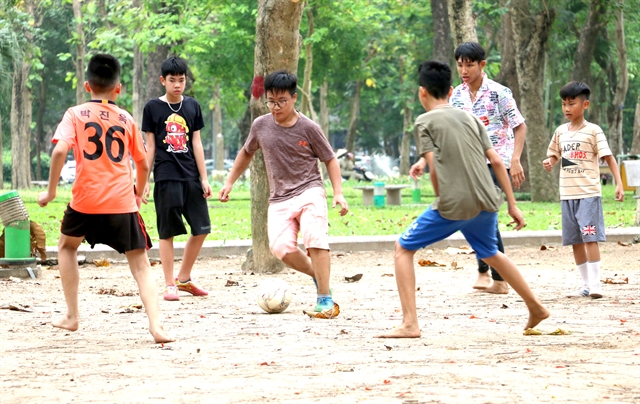.jpg) Society
Society

 |
| Children enjoy playing football in Thống Nhất Park, Hà Nội. VNS Illustrative Photo Đoàn Tùng |
HÀ NỘI – As the World Day Against Child Labour is observed on June 12, Việt Nam has confirmed its strong commitment to eliminating child labour in all forms, particularly hazardous and exploitative work that robs their right to a fulfilling childhood.
Striking progress
Over the past few decades, the country has made strides in protecting children’s rights, especially efforts to reduce child labour, one of the most daunting challenges in developing countries.
As an early signatory to the United Nations Convention on the Rights of the Child and the International Labour Organisation (ILO)’s Conventions on Minimum Age and Worst Forms of Child Labour, Việt Nam perfected its child protection legal system, with the 2016 Child Law and 2019 Labour Code stipulating working ages, prohibited practices and stringent requirements allowing children aged 15-17 to work.
The country’s efforts have yielded encouraging outcomes. According to the report from the National Statistics Office of Việt Nam and the ILO released early this year, some 731,000 children aged 5-17 are currently engaged in labour nationwide, representing 3.5 per cent of all children as compared to the 9.1 per cent rate in 2018.
However, the report revealed that over 84 per cent of working children live in rural areas, engaging in agriculture, livestock, handicrafts and small-scale trading as family support labour. More than 40 per cent of the children work 40 hours or more per week, equivalent to adults, affecting their physical and mental health while severely impeding their educational progress, increasing the risks of school dropout, poverty recurrence and lost development opportunities.
Experts pointed to poverty, lack of access to education, poor public awareness and demand for cheap labour, especially in the informal sector, as the main drivers of child labour.
Against this backdrop, Việt Nam has put in place strict measures, including the national programme on prevention and reduction of child labour for 2021-2025. It is among the 15 pioneering countries participating in the Alliance 8.7 against global child labour.
Additionally, Việt Nam has strengthened labour inspection and child protection systems at production facilities while establishing inter-agency coordination mechanisms between educational institutions, medical centres and civil society organisations. The country provides rehabilitation support for children who have experienced labour exploitation through scholarships, tuition assistance, psychological counselling and community service connections.
The dramatic reduction in child labour rates in less than a decade reflects Việt Nam's persistent, systematic and human-centred efforts. However, significant challenges remain, particularly in ethnic community areas and remote regions where multidimensional poverty and inadequate public services continue to pose major barriers.
Looking ahead, Việt Nam hopes to eradicate all forms of hazardous labour that hinder children’s comprehensive development. This requires not only State efforts but also partnerships from communities, businesses, social organisations and families to ensure all Vietnamese children can live, learn and develop in safe and healthy environments.
Sustainable measures to prevent child labour
Việt Nam’s strategy goes beyond legislation and awareness campaigns. It tackles the roots of the problem — poverty, lack of access to education and family hardship — through meaningful policy reforms.
The Politburo’s decision to implement tuition-free education for public school students from preschool through high school represents a drastic step. Taking effect in the next academic year, the policy aims to expand educational opportunities and reduce the financial burden on families, particularly in rural and disadvantaged regions.
Experts said that international cooperation is an effective solution to addressing the root causes of increasing child labour. International projects typically focus on livelihood support for vulnerable families while creating conditions for children to participate in appropriate and safe work according to legal regulations.
The technical assistance project to enhance national capacity to prevent and reduce child labour in Việt Nam (ENHANCE), implemented by the ILO in An Giang Province, Hồ Chí Minh City and Hà Nội, has contributed significantly to reducing child labour in Việt Nam. After 10 years of implementation, the project has achieved numerous positive results, from supporting vulnerable families and developing livelihood-education models to providing career guidance skills for youth at risk of early labour exploitation.
Most recently, ENHANCE organised two Training of Trainers courses in Hà Nội for nearly 70 counsellors and teachers in the textile industry, helping them improve career guidance skills for at-risk youth. With professional knowledge and soft skills, they can properly guide students, helping them choose appropriate vocational paths instead of dropping out for early employment. Initial results show that training institutions have significantly improved counselling quality and retained students longer, helping to prevent child labour in the textile supply chain, one of the industries with a high potential risk. VNA/VNS

.jpg)


